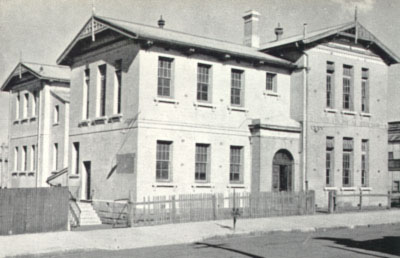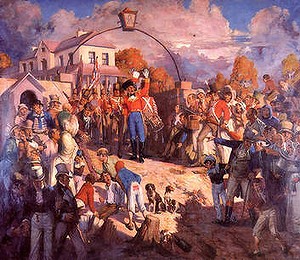|
Sydney Technical High School
Sydney Technical High School (STHS) is a government-funded single-sex academically selective secondary day school for boys, located in Bexley, a southern suburb of Sydney, New South Wales, Australia. Founded in 1911 as part of Sydney Technical College, the school was one of the six original New South Wales selective schools and caters for boys from Year 7 to Year 12. The school is colloquially abbreviated to Sydney Tech, STHS or simply Tech. Admission to Year 7 is based on an external selective test held in Year 6 during March. Entrance to Years 8, 9 and 10 is based on the submission of an application form and an interview. Admission to Year 11 is based on the submission of an application form, placement tests in Mathematics and English, and an interview. Academic achievement The school consistently achieves superior results in external assessments, such as the NAPLAN, the ICAS, the Record of School Achievement, and in particular, the Year 12 Higher School Certificate ... [...More Info...] [...Related Items...] OR: [Wikipedia] [Google] [Baidu] |
William Of Wykeham
William of Wykeham (; 1320 or 1324 – 27 September 1404) was Bishop of Winchester and Chancellor of England. He founded New College, Oxford, and New College School in 1379, and founded Winchester College in 1382. He was also the clerk of works when much of Windsor Castle was built. Early life William of Wykeham (born William Longe) was the son of John Longe, a freeman from Wickham in Hampshire. He was educated at a school in Winchester, and probably enjoyed early patronage from two local men, Sir Ralph Sutton, constable of Winchester Castle, and Sir John Scures, lord of the manor of Wickham, and then from Thomas Foxley, Constable of Windsor Castle. In 1349, Wykeham was described as a chaplain when he was appointed rector of Irstead in Norfolk, a position which was in the gift of the Crown. Builder William became secretary to the constable of Winchester Castle and in that capacity learned about building. This led to architectural work for King Edward III, for wh ... [...More Info...] [...Related Items...] OR: [Wikipedia] [Google] [Baidu] |
Urban Area
An urban area, built-up area or urban agglomeration is a human settlement with a high population density and infrastructure of built environment. Urban areas are created through urbanization and are categorized by urban morphology as cities, towns, conurbations or suburbs. In urbanism, the term contrasts to rural areas such as villages and hamlets; in urban sociology or urban anthropology it contrasts with natural environment. The creation of earlier predecessors of urban areas during the urban revolution led to the creation of human civilization with modern urban planning, which along with other human activities such as exploitation of natural resources led to a human impact on the environment. "Agglomeration effects" are in the list of the main consequences of increased rates of firm creation since. This is due to conditions created by a greater level of industrial activity in a given region. However, a favorable environment for human capital development would also be genera ... [...More Info...] [...Related Items...] OR: [Wikipedia] [Google] [Baidu] |
New South Wales Corps
The New South Wales Corps (sometimes called The Rum Corps) was formed in England in 1789 as a permanent regiment of the British Army to relieve the New South Wales Marine Corps, who had accompanied the First Fleet to Australia, in fortifying the Colony of New South Wales. It gained notoriety for its trade in rum and disobedient behaviour during its service and was disbanded in 1818. History Formation The regiment was formed in England in June 1789 as a permanent unit to relieve the New South Wales Marine Corps, who had accompanied the First Fleet to Australia. The regiment began arriving as guards on the Second Fleet in 1790. The regiment, led by Major Francis Grose, consisted of three companies numbering about 300 men. Although drafts were sent from Britain to reinforce the regiment throughout its time in Australia, full strength was never to exceed 500. A fourth company was raised from those Marines wishing to remain in New South Wales under Captain George Johnston, who ... [...More Info...] [...Related Items...] OR: [Wikipedia] [Google] [Baidu] |
John Harris (Australian Settler)
John Harris (1754 – April 1838) was a military surgeon, naval officer and landowner, who arrived in New South Wales on the second fleet and ultimately become one of the major landowners in New South Wales, Australia. Early life John Harris, who was the son of John and Ann Harris was born in 1754 on the Moy McIlmurry farm in Moneymore, County Londonderry, Ireland. Harris lived a prosperous life, with his family working as tenant farmers on the Salters Company which received a grant from the Crown in 1611. In Harris’ early schooling years, he was taught Latin, mathematics and classics, however, there was no evidence in any higher education except studying at the University of Edinburgh for a medical profession. In 1789, an opportunity arose for Harris to join the 102nd army regiment and travel to New South Wales on the Second Fleet and included an instant promotion. Harris agreed to the opportunity and was immediately promoted to Surgeon. The Second Fleet was a str ... [...More Info...] [...Related Items...] OR: [Wikipedia] [Google] [Baidu] |
Sydney Technical High School - 1925
Sydney ( ) is the capital city of the state of New South Wales, and the most populous city in both Australia and Oceania. Located on Australia's east coast, the metropolis surrounds Sydney Harbour and extends about towards the Blue Mountains to the west, Hawkesbury to the north, the Royal National Park to the south and Macarthur to the south-west. Sydney is made up of 658 suburbs, spread across 33 local government areas. Residents of the city are known as "Sydneysiders". The 2021 census recorded the population of Greater Sydney as 5,231,150, meaning the city is home to approximately 66% of the state's population. Estimated resident population, 30 June 2017. Nicknames of the city include the 'Emerald City' and the 'Harbour City'. Aboriginal Australians have inhabited the Greater Sydney region for at least 30,000 years, and Aboriginal engravings and cultural sites are common throughout Greater Sydney. The traditional custodians of the land on which modern Sydney stands are the ... [...More Info...] [...Related Items...] OR: [Wikipedia] [Google] [Baidu] |



.jpg)

